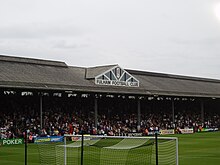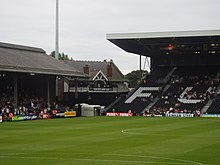Craven Cottage
[4] Next to Bishop's Park on the banks of the River Thames,[5] it was originally a royal hunting lodge and has a history dating back over 300 years.
[2] The Cottage was lived in by Edward Bulwer-Lytton[2] (who wrote The Last Days of Pompeii[12]) and other somewhat notable (and moneyed) persons[2] until it was destroyed by fire in May 1888.
Sir Arthur Conan Doyle, Jeremy Bentham, Florence Nightingale and even Queen Victoria are reputed to have stayed there, although there is no real evidence for this.
[2] In a scheme costing £15,000[2] (a record for the time[17]), he built a pavilion (the present-day 'Cottage' itself[2]) and the Stevenage Road Stand,[2] in his characteristic red brick style.
There were also plans for Henry Norris to build a larger stadium on the other side of Stevenage Road but there was little need after the merger idea failed.
[4] It was the largest attendance ever at Craven Cottage and the record remains today, unlikely to be bettered as it is now an all-seater stadium with currently no room for more than 29,700.
[38] Eric Miller committed suicide five years later after a political and financial scandal,[39] and had shady dealings with trying to move Fulham away from the Cottage.
[34] On Boxing Day 1963, Craven Cottage was the venue of the fastest hat-trick in the history of the English football league, which was completed in less than three minutes, by Graham Leggat.
[40][41] The international record is held by Jimmy O'Connor, an Irish player who notched up his hat trick in 2 minutes 14 seconds in 1967.
In December 2003, plans were unveiled for £8 million worth of major refurbishment work to bring it in line with Premier League requirements.
This venue is suitable for Australia because most of the country's top players are based in Europe, and West London has a significant community of expatriate Australians.
Other events have included brass bands, Michael Jackson (although just walking on the pitch, as opposed to performing),[74] Travis playing, Arabic dancing, keepie uppie professionals and presentational awards.
[84] On 27 July 2012, Fulham FC were granted permission to redevelop the Riverside Stand, increasing the capacity of Craven Cottage to 30,000 seats.
[85][86] Beforehand various rumours arose including plans to return to ground-sharing with QPR in a new 40,000 seater White City stadium,[87][88] although these now appear firmly on hold with the construction of the Westfield shopping centre on the proposed site.
The board seem to have moved away from their ambition to make Fulham the "Manchester United of the south" as it became clear how expensive such a plan would be.
[89] With large spaces of land at a premium in south-west London, Fulham appear to be committed to a gradual increase of the ground's capacity often during the summer between seasons.
[92] With Mohamed Al-Fayed selling Harrods department store for £1.5 billion in May 2010[93] a detailed plan emerged in the Riverside Stand as the only viable area for expansion.
The scheme involved the demolition of the back of the Riverside Stand with a new tier of seating added on top of the current one and a row of corporate boxes; bringing Craven Cottage up to 30,000 capacity.
[94] Taking into account local residents, the proposal would: reopen the riverside walk; light pollution would be reduced with the removal of floodlight masts; new access points would make match-day crowds more manageable; and the new stand would be respectful in design to its position on the River Thames.
The stand had terracing until the reopening of the ground in 2004, when it was replaced with seating in order to comply with league rules following the Taylor Report.
[102] Flags of every nationality in the Fulham squad were hung from the roofing, although they were removed after the 2006–07 season commenced and there is now an electronic scoreboard in place.
[101] Jimmy Hill once referred to the Riverside being "a bit like the London Palladium" as Blocks V & W (the middle section) were often filled with the rich and famous (including often Al-Fayed).
[100] Designed by Archibald Leitch,[100] the stand contains the ticket office[100] and club shop[100] and features original 'Bennet' wooden seating.
The Cottage Pavilion dates back to 1905 along with the Johnny Haynes Stand,[3] built by renowned football architect Archibald Leitch.
[3][122] Besides being the changing rooms, the Cottage (also called The Clubhouse) is traditionally used by the players' families and friends who sit on the balcony to watch the game.
It encapsulates the now-famous moment, when fans facing defeat against Hamburg SV in the Europa League semi-final roused the players with the chant of "Stand up if you still believe".
[123][124][125] In the three other corners of the ground there are what have been described as large 'filing cabinets', which are corporate boxes on three levels, but currently the box on the other side of the Putney End has been removed due to the redevelopment of the Riverside[126] Craven Cottage hosted the Northern Ireland versus Cyprus 1974 World Cup Qualifier on 8 May 1973, a match moved from Belfast due to The Troubles.
In recent years, Craven Cottage has hosted several International Friendly matches, including the Ireland national team who played Colombia and Nigeria there in May 2008[131] and May 2009[132] respectively and Oman in 2012.
[135][136] On 26 May 2011, Craven Cottage hosted the game of 2011 UEFA Women's Champions League Final between Lyon and Potsdam.
On 27 March 2018, Australia played host to Colombia in the international friendlies, the match ended 0-0, both teams having qualified for the 2018 World Cup Finals in Russia.















